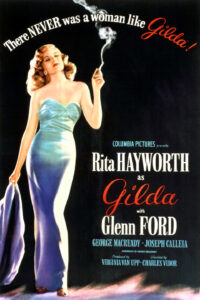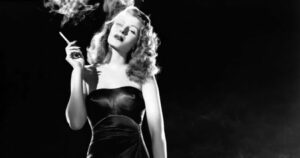“Gilda” – a Legend of Cinema Noir

Title: “Gilda”
Release Date: 1946
Director: Charles Vidor
Cast: Rita Hayworth, Glenn Ford, George Macready, Joseph Calleia, Steven Geray
The scenes with the titular Gilda, i.e. Rita Hayworth, went down in cinema history. The dark love story lined with criminal intrigue wouldn’t be so fascinating if it weren’t for the beautiful actress’s sensual dance and storm of curls.
Charles Vidor’s “Gilda” from 1946 can be classified as black cinema, a popular trend in American film of the 1940s. It is not a classic example of noir, but the director uses this aesthetic to create a mysterious and extremely absorbing picture. The plot of the love triangle – Gilda (Rita Haywort), her husband (George Macready) and Johnny Farrell (Glenn Ford) – comes to the fore. The film is set during World War II in Argentina, among European expatriates. The time-space, plot and atmosphere of the work therefore situate “Gilda” very close to Michael Curtiz’s “Casablanca”.
Ballin Mundson, a casino owner with an unclear but rather dark past, hires Johnny, a gambling scammer he met by chance, as his chief of personal security. Soon he also introduces his beautiful wife Gilda to his co-worker. It turns out that the newly married wife and Johnny were previously lovers, and their passion is rekindled with redoubled, destructive force. When Mundson fakes his death, the widow inherits the entire fortune and marries Farrell. However, he intends to take revenge for Gilda’s infidelity and isolates her from the world.

The dark mystery of “Gilda”
“Gilda” is a film that captivates even an aura of mystery present on many levels. First of all, we know nothing for sure about any of the characters in the picture. Both Gilda and Johnny and Mundson do not reveal details of their past. The viewer builds knowledge about these characters from the remains of information.
Ballin is a German emigrant, which acquires a particularly ambiguous sense in connection with the time of action (World War II), while Gilda and Farrell are Americans. It is known that the girl was a dancer in nightclubs and has numerous amorous conquests on her account. However, the most information about the characters’ dark secrets comes from two background characters – a checkroom attendant and a police inspector. Nevertheless the viewer does not have access to their secret knowledge, which makes the film world really intriguing.
The aura of mystery in “Gilda” is also built by the space-time setting, somewhat exotic and significant. Argentina is a place where many Europeans fleeing the destruction, but also Nazi criminals stayed during the war. Additionally, the film features a nocturnal world constructed by casinos, nightclubs, and shady business deals. It is worth noting the clear affinity of “Gilda” with German Expressionism of the 1920s. The time-space here is so dark that it sometimes gives the impression of a surrealistic nightmare. Scenes with exaggerated shadows of characters, symbolic shots of a masked ball, and claustrophobic interiors play a special role.

“Gilda” is also an evil almost hanging in the air. It is, of course, attributed to the title character, a typical femme fatale, capable of leading any man to disaster. However, other characters are also marked by evil. Gilda’s husband with his cane containing a deadly blade is reminiscent of a sadistic murderer. What is more, one may suspect him of exceptionally perverse inclinations – he looks impotent, and says to his wife that hatred excites him most in the world.
“Gilda” – love or rivalry?
“Gilda”, however, is first and foremost a wonderful acting performance by Rita Hayworth. Almost every scene from this film with her participation went down in the history of cinema. The special moment – the character’s introduction – when Gilda reveals herself to the viewer with a storm of long, fluffy hair is an acting masterpiece that has earned her a permanent place in the pantheon of Hollywood stars. Rita Hayworth’s image has entered the canon of the femme fatale. Beautiful, insanely erotic, wearing sexy body-hugging clothes, enveloped in cigarette smoke – she is the embodiment of men’s deepest desires and greatest fears.
Gilda is a combination of a mysterious lady and a courtesan, which is best shown in the loud scene in which Rita Hayworth performs the song “Put the Blame on Mame” and sensually pulls off her gloves. After this number is played, there is a rather brutal moment when the character invites men to help her unzip her dress.
It is worth noting, however, that despite the apparent attributes of a fatal woman, Gilda is not the cause of the man’s doom. On the contrary, she seems to be very much objectified. Gilda is primarily an object of rivalry between Mundson and Johnny, a sort of precious toy in their hands. Each of the men wants to use her in his own way, and she herself falls prey to the men’s intrigues. Gilda constantly senses her defeat, and even fears death. The motif of a superstitious woman is repeated several times in the film. In one scene, Gilda is forced to toast her own doom, which terrifies her.
All the dark aspects of Gilda make the happy ending, which after all takes place before our eyes, seem unbelievable. It fits, however, into the internal logic of this work. The rescue of the protagonists is as absurd as the sinister world of Gilda which resembles a nightmare.

